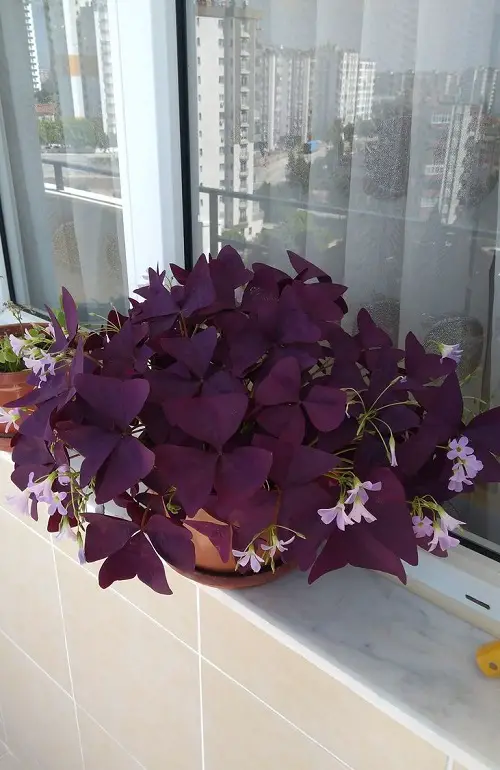Producing colorful flowers that last several days through spring, summer, and fall, here are Tricks to Make Your Oxalis Bloom abundantly!
Oxalis, commonly known as false shamrock or wood sorrel, is a tropical plant sporting clover-like leaves and tiny, trumpet-shaped flowers in purple, pink, white, and even combinations. Here are some tricks to make your Oxalis bloom better and brighter.
How Long Do Oxalis Blooms Last
Oxalis flowers almost all year, producing blooms that last several days at a time. Appearing in varied hues, there are several flowering varieties to pick from. Some are even fragrant, such as the Oxalis pocockiae, which smells like fresh coconut!
Native to Brazil and South Africa, Oxalis’ growth cycle differs from regular potted plants, and understanding this is the best way to encourage more blooms. The rest period the plant needs to recover and fortify for upcoming seasons is crucial.
The plant often enters dormancy after flowering, which may occur at different times depending on the growing conditions and variety. Regular deadheading and removing wilted flowers can boost blooms over an extended period.
Tricks to Make Your Oxalis Bloom
1. Understand the Dormancy

Understanding the dormancy period is the first and most important trick to getting your Oxalis to bloom. After flowering, Oxalis often enters a resting phase where its leaves may turn yellow or brown and die back.
This sometimes occurs in summer when temperatures exceed 85 F (29 C), and some species become inactive in winter when the temperature goes below 50 F (10 C).
The plant conserves energy during this time to prepare for its next bloom cycle. Reduce watering and stop fertilizing entirely during dormancy, and keep your plant in a cool, dark space.
Depending on the species, this resting period lasts 1-3 months. Once new growth appears, you can resume normal care again, which signals the plant’s readiness to bloom again. This is a ripe time to propagate Oxalis by dividing its many small bulbs.
2. Let it Stay Rootbbound

Another way to encourage blooming is by allowing your Oxalis to become slightly rootbound. When the roots are a little crowded in the pot, the plant directs more energy toward flowering rather than growing roots and foliage.
Repot only if its roots grow from the pot’s drainage holes or the soil becomes compacted. If repotting is necessary, choose a pot only slightly larger than the current one to maintain the rootbound condition that supports blooming.
3. Force them Indoors to Bloom

You can “force” potted Oxalis bulbs indoors before moving them outside. To do this, place the bulbs in bright light in a room with cool temperatures of 55-60 F (13-16 C). Keep the soil evenly moist but never drenched.
Under these conditions, the bulbs will start to grow, and once blooms appear, they often continue flowering for several months. This method is a great way to enjoy flowers indoors before transplanting to the garden.
4. Provide Sufficient Light

Oxalis thrives in bright, indirect sunlight, which helps it produce more flowers. Place indoor plants near an east-facing window where they can receive soft morning light. Avoid direct sunshine for too long, especially in the afternoon, as it can scorch the leaves.
If your home doesn’t have enough natural light, you can use a grow light to provide the recommended brightness. Outdoors, choose a location with partial shade, such as under a tree or on a patio that gets morning sun and afternoon shade.
If the plant stretches and becomes leggy without blooming, it likely needs more light. On the other hand, pale or scorched leaves mean it’s getting too much direct sunlight.
5. Right Temperature Levels
Oxalis grows best in moderate temperatures, ideally between 60–75 F (15–24 C). Indoors, keep the plant away from cold drafts near windows or doors, and avoid placing it near heating vents, radiators, or air conditioners. Extremities stress and delay blooming.
When outdoors, ensure the plant gets shelter from extreme heat and frost. During summer, when temperatures exceed 85 F, move the plant to a cooler, shaded area. And when frost arrives, bring your potted Oxalis indoors or cover your garden plant with frost cloths.
6. Give a Bit of Stress
Mild stress, such as slightly reduced watering or cooler nighttime temperatures, can encourage blooming. Avoid over-fertilizing, as too much nitrogen promotes leafy growth instead of flowers.
Opt for a fertilizer with a lower nitrogen content and higher potassium levels, which support healthy flower development. This balanced approach can help your Oxalis shift its energy toward producing blooms.





